Spatial-Temporal Evolution and Driving Factors of the Coupling Coordination between Urbanization and Urban Resilience: A Case Study of the 167 Counties in Hebei Province
Abstract
:1. Introduction
2. Literature Review and Theoretical Framework
2.1. Literature Review
2.2. The Theoretical Framework between Urban Resilience and Urbanization
3. Materials and Methods
3.1. Research Area
3.2. Construction of Evaluation Indicators
3.3. Driving Factors
3.4. Data Sources
3.5. Methods
3.5.1. Entropy Weighting Method
3.5.2. Coupling Coordination Degree Model (CCDM)
3.5.3. Spatial Autocorrelation Analysis
3.5.4. Spatial Durbin Model
4. Results
4.1. Overview of Urbanization and Urban Resilience
4.1.1. Urbanization’s Spatial-Temporal Development
4.1.2. Urban Resilience’s Spatial-Temporal Development
4.2. The Spatial-Temporal Evolution of Coupling Coordination Degree
4.2.1. Coupling Coordination Degree
4.2.2. Coupling Coordination Type Evolution
4.2.3. Spatial Autocorrelation Analysis of CCD
4.3. Driving Force of Coupling Coordination Degree
5. Discussion
5.1. Discussion on Evaluation Index System
5.2. Interaction between Urbanization and Urban Resilience
5.3. Discussion on Driving Factors
5.4. Policy Implications
- (1)
- The government should multi-dimensionally promote the urban elements and coordinate the balanced development of urbanization and urban resilience. In terms of the spatial form, the government should optimize the land and space layout, delineate the urban development boundaries, and improve the urban form. In terms of governance, the government should increase its financial input to optimize the urban infrastructure structure, and improve the government water supply, gas supply and heat supply, as well as the urban functions such as flood control and temperature control, which are of great significance to improving urban resilience and enhancing the level of urban disaster resistance. The government should also focus on industrial upgrading and technological innovation as strong economic strength and a complete economic structure are important supporting forces for cities to resist risk shocks.
- (2)
- Different policies are required by different counties, and the development strategies of them should be formulated based on each county’s own conditions. For the central county and its surrounding peripheral counties, which have good location advantages and industrial foundations, as well as a strong carrying capacity for the resources and environmental factors, it is essential to keep enhancing the quality and efficiency of the industrial supporting facilities and upgrade the municipal public facilities to ensure resilience in the process of urbanization. While the remaining peripheral counties, such as Zhangbei County in the northwest, should encourage the development of the ecological innovation belts, and enhance the urbanization process while guaranteeing urban resilience.
- (3)
- The government should attach importance to the spatial spillover effect, and let the central counties drive the coordinated development of the peripheral counties. Each county should actively break the thinking constraints of the cooperation model that are brought about by the boundaries of the administrative jurisdiction, thereby maximizing the radiating and driving function of the central county. Relying on a more complete regional infrastructure network and a smoother flow of production factors will narrow the coordination gap between the counties by point and area and improve the network structure of a multi-party collaborative governance of urban resilience.
5.5. Lack of Research and Prospects
6. Conclusions
Author Contributions
Funding
Institutional Review Board Statement
Informed Consent Statement
Data Availability Statement
Acknowledgments
Conflicts of Interest
References
- Lin, B.; Zhu, J. Impact of China’s new-type urbanization on energy intensity: A city-level analysis. Energy Econ. 2021, 99, 105292. [Google Scholar] [CrossRef]
- Liu, Y.; Wang, M.; Feng, C. Inequalities of China’s regional low-carbon development. J. Environ. Manag. 2020, 274, 111042. [Google Scholar] [CrossRef]
- Yu, B. Ecological effects of new-type urbanization in China. Renew. Sustain. Energy Rev. 2021, 135, 110239. [Google Scholar] [CrossRef]
- Hu, Z.; Zhang, X.; Cui, J.; Zhang, L.; Ahmed, W. A survey-based analysis of the public’s willingness for disaster relief in China. Nat. Hazards 2021, 107, 2205–2225. [Google Scholar] [CrossRef]
- Childers, D.L.; Pickett, S.T.; Grove, J.M.; Ogden, L.; Whitmer, A. Advancing urban sustainability theory and action: Challenges and opportunities. Landsc. Urban Plan 2014, 125, 320–328. [Google Scholar] [CrossRef]
- Coaffee, J.; Lee, P. Urban Resilience: Planning for Risk, Crisis and Uncertainty; Palgrave Macmillan: London, UK, 2016. [Google Scholar]
- Kong, L.; Mu, X.; Hu, G.; Zhang, Z. The application of resilience theory in urban development: A literature review. Environ. Sci. Pollut. Res. 2022, 29, 49651–49671. [Google Scholar] [CrossRef] [PubMed]
- The National Development and Reform Commission Suggest Promoting the New-Type Urbanization. Available online: http://www.gov.cn/zhengce/zhengceku/2022-03/22/content_5680416.htm (accessed on 15 March 2022).
- Feng, W.; Liu, Y.; Qu, L. Effect of land-centered urbanization on rural development: A regional analysis in China. Land Use Policy 2019, 87, 104072. [Google Scholar] [CrossRef]
- Tian, L.; Ge, B.Q.; Li, Y.F. Impactsofstate-led and bottom-upurbanizationonlandusechangeintheperi-urbanareasofShanghai: Plannedgrowth or uncontrolledsprawl? Cities 2017, 60, 476–486. [Google Scholar] [CrossRef]
- Cai, J.; Li, X.; Liu, L.; Chen, Y.; Wang, X.; Lu, S. Coupling and coordinated development of new urbanization and agro-ecological environment in China. Sci. Total Environ. 2021, 776, 145837. [Google Scholar] [CrossRef]
- Li, L.; Liu, Y. Spatial-temporal patterns and driving forces of sustainable urbanization in China since 2000. J. Urban Plan Dev. 2019, 145, 5019014. [Google Scholar] [CrossRef]
- Lv, T.; Wang, L.; Zhang, X.; Xie, H.; Lu, H.; Li, H.; Liu, W.; Zhang, Y. Coupling Coordinated Development and Exploring Its Influencing Factors in Nanchang, China: From the Perspectives of Land Urbanization and Population Urbanization. Land 2019, 8, 178. [Google Scholar] [CrossRef] [Green Version]
- Holling, C.S. Resilience and stability of ecological systems. Annu. Rev. Ecol. Syst. 1973, 4, 1–23. [Google Scholar] [CrossRef] [Green Version]
- Büyüközkan, G.; Ilıcak, Ö.; Feyzioğlu, O. A review of urban resilience literature. Sustain. Cities Soc. 2022, 77, 103579. [Google Scholar] [CrossRef]
- Rose, A. Resilience and sustainability in the face of disasters. Environ. Innov. Soc. Transit. 2011, 1, 96–100. [Google Scholar] [CrossRef]
- Tobin, G.A. Sustainability and community resilience: The holy grail of hazards planning? Glob. Environ. Chang. Part B Environ. Hazards 1999, 1, 13–25. [Google Scholar] [CrossRef]
- Borsekova, K.; Nijkamp, P.; Guevara, P. Urban resilience patterns after an external shock: An exploratory study. Int. J. Disaster Risk Reduct. 2018, 31, 381–392. [Google Scholar] [CrossRef]
- Tyler, S.; Moench, M. A framework for urban climate resilience. Clim Dev 2012, 4, 311–326. [Google Scholar] [CrossRef]
- Meerow, S.; Newell, J.P.; Stults, M. Defining urban resilience: A review. Landsc. Urban Plan 2016, 147, 38–49. [Google Scholar] [CrossRef]
- Leichenko, R. Climatechange and urbanresilience. Curr. Opin. Env. Sustain. 2011, 3, 164–168. [Google Scholar] [CrossRef]
- Cimellaro, G.P.; Reinhorn, A.M.; Bruneau, M. Framework for analytical quantification of disaster resilience. Eng. Struct. 2010, 32, 3639–3649. [Google Scholar] [CrossRef]
- Arup Partners International Limited. City Resilience Index: City Resilience Framework. 2014. Available online: www.urban-response.org/system/files/content/resource/files/main/city-resilience-framework-arup-april-2014.pdf (accessed on 28 March 2022).
- Ribeiro, P.J.G.; Pena Jardim Gonçalves, L.A. Urban resilience: A conceptual framework. Sustain. Cities Soc. 2019, 50, 101625. [Google Scholar] [CrossRef]
- Woolf, S.; Twigg, J.; Parikh, P.; Karaoglou, A.; Cheaib, T. Towards measurable resilience: A novel framework tool for the assessment of resilience levels in slums. Int. J. Disaster Risk Reduct. 2016, 19, 280–302. [Google Scholar] [CrossRef] [Green Version]
- Assarkhaniki, Z.; Rajabifard, A.; Sabri, S. The conceptualisation of resilience dimensions and comprehensive quantification of the associated indicators: A systematic approach. Int. J. Disaster Risk Reduct. 2020, 51, 101840. [Google Scholar] [CrossRef]
- Hu, M.; Zhang, J.; Huang, J. Assessing social-ecological system resilience in mainland China. Pol. J. Environ. Stud. 2018, 27, 1085–1096. [Google Scholar] [CrossRef] [Green Version]
- Hung, H.; Yang, C.; Chien, C.; Liu, Y. Building resilience: Mainstreaming community participation into integrated assessment of resilience to climatic hazards in metropolitan land use management. Land Use Policy 2016, 50, 48–58. [Google Scholar] [CrossRef]
- Guidotti, R.; Gardoni, P.; Rosenheim, N. Integration of physical infrastructure and social systems in communities’ reliability and resilience analysis. Reliab. Eng. Syst. Saf. 2019, 185, 476–492. [Google Scholar] [CrossRef]
- Feng, X.; Xiu, C.; Li, J.; Zhong, Y. Measuring the Evolution of Urban Resilience Based on the Exposure–Connectedness–Potential (ECP) Approach: A Case Study of Shenyang City, China. Land 2021, 10, 1305. [Google Scholar] [CrossRef]
- Rasoulkhani, K.; Mostafavi, A. Resilience as an emergent property of human-infrastructure dynamics: A multi-agent simulation model for characterizing regime shifts and tipping point behaviors in infrastructure systems. PLoS ONE 2018, 13, e207674. [Google Scholar] [CrossRef] [Green Version]
- Liu, S.; Peng, F.; Qiao, Y.; Zhang, J. Evaluating disaster prevention benefits of underground space from the perspective of urban resilience. Int. J. Disaster Risk Reduct. 2021, 58, 102206. [Google Scholar] [CrossRef]
- Yoon, D.K.; Kang, J.E.; Brody, S.D. A measurement of community disaster resilience in Korea. J. Environ. Plan. Manag. 2016, 59, 436–460. [Google Scholar] [CrossRef]
- Suarez, M.; Gomez-Baggethun, E.; Benayas, J.; Tilbury, D. Towards an Urban Resilience Index: A Case Study in 50 Spanish Cities. Sustainability 2016, 8, 774. [Google Scholar] [CrossRef] [Green Version]
- Cohen-Shacham, E.; Walters, G.; Janzen, C.; Maginnis, S. Nature-Based Solutions to Address Global Societal Challenges; IUCN: Gland, Switzerland, 2016; Volume 97, pp. 2016–2036. [Google Scholar]
- Feng, X.H.; Xiu, C.L.; Bai, L.M.; Zhong, Y.X.; Wei, Y. Comprehensive evaluation of urban resilience based on the perspective of landscape pattern: A case study of Shenyang city. Cities 2020, 104, 102722. [Google Scholar] [CrossRef]
- Luo, X.; Cheng, C.; Pan, Y.; Yang, T. Coupling Coordination and Influencing Factors of Land Development Intensity and Urban Resilience of the Yangtze River Delta Urban Agglomeration. Water 2022, 14, 1083. [Google Scholar] [CrossRef]
- Meerow, S.; Pajouhesh, P.; Miller, T.R. Social equity in urban resilience planning. Local Environ. 2019, 24, 793–808. [Google Scholar] [CrossRef] [Green Version]
- Lauer, M.; Albert, S.; Aswani, S.; Halpern, B.S.; Campanella, L.; La Rose, D. Globalization, Pacific Islands, and the paradox of resilience. Glob. Environ. Chang. 2013, 23, 40–50. [Google Scholar] [CrossRef]
- Feng, Z.; Tang, Y.; Yang, Y.; Zhang, D. Relief degree of land surface and its influence on population distribution in China. J. Palaeogeogr. Sci. 2008, 18, 237–246. [Google Scholar] [CrossRef]
- Wu, M.; Wu, Z.; Ge, W.; Wang, H.; Shen, Y.; Jiang, M. Identification of sensitivity indicators of urban rainstorm flood disasters: A case study in China. J. Hydrol. 2021, 599, 126393. [Google Scholar] [CrossRef]
- Fleischhauer, M. The Role of Spatial Planning in Strengthening Urban Resilience. NATO Sci. Peace Secur. Ser. C 2008, 273–298. [Google Scholar] [CrossRef]
- He, S.; Yu, S.; Li, G.; Zhang, J. Exploring the influence of urban form on land-use efficiency from a spatiotemporal heterogeneity perspective: Evidence from 336 Chinese cities. Land Use Policy 2020, 95, 104576. [Google Scholar] [CrossRef]
- Tao, Y.; Zhang, Z.; Ou, W.; Guo, J.; Pueppke, S.G. How does urban form influence PM2.5 concentrations: Insights from 350 different-sized cities in the rapidly urbanizing Yangtze River Delta region of China, 1998–2015. Cities 2020, 98, 102581. [Google Scholar] [CrossRef]
- Wu, X.; Guo, J. Disaster Probability, Optimal Government Expenditure for Disaster Prevention and Mitigation, and Expected Economic Growth; Springer: Berlin/Heidelberg, Germany, 2021; pp. 3–44. [Google Scholar]
- Zhang, J.; Qu, Y.; Zhang, Y.; Li, X.; Miao, X. Effects of FDI on the efficiency of government expenditure on environmental protection under fiscal decentralization: A spatial econometric analysis for China. Int. J. Environ. Res. Public Health 2019, 16, 2496. [Google Scholar] [CrossRef] [PubMed] [Green Version]
- Chelleri, L.; Waters, J.J.; Olazabal, M.; Minucci, G. Resilience trade-offs: Addressing multiple scales and temporal aspects of urban resilience. Environ. Urban 2015, 27, 181–198. [Google Scholar] [CrossRef] [Green Version]
- Gao, Y.P.; Chen, W.J. Study on the coupling relationship between urban resilience and urbanization quality-A case study of 14 cities of Liaoning Province in China. PLoS ONE 2021, 16, e0244024. [Google Scholar] [CrossRef]
- Chen, Y.; Su, X.; Zhou, Q. Study on the Spatiotemporal Evolution and Influencing Factors of Urban Resilience in the Yellow River Basin. Int. J. Environ. Res. Public Health 2021, 18, 10231. [Google Scholar] [CrossRef]
- Chen, Y.; Zhu, M.; Zhou, Q.; Qiao, Y. Research on Spatiotemporal Differentiation and Influence Mechanism of Urban Resilience in China Based on MGWR Model. Int. J. Environ. Res. Public Health 2021, 18, 1056. [Google Scholar] [CrossRef]
- Wang, Z.; Liang, L.; Sun, Z.; Wang, X. Spatiotemporal differentiation and the factors influencing urbanization and ecological environment synergistic effects within the Beijing-Tianjin-Hebei urban agglomeration. J. Environ. Manag. 2019, 243, 227–239. [Google Scholar] [CrossRef]
- Chen, D.; Lu, X.; Liu, X.; Wang, X. Measurement of the eco-environmental effects of urban sprawl: Theoretical mechanism and spatiotemporal differentiation. Ecol. Indic. 2019, 105, 6–15. [Google Scholar] [CrossRef]
- Delgado-Ramos, G.C.; Guibrunet, L. Assessing the ecological dimension of urban resilience and sustainability. Int. J. Urban Sustain. Dev. 2017, 9, 151–169. [Google Scholar] [CrossRef]
- Zhou, T.; Jiang, G.; Zhang, R.; Zheng, Q.; Ma, W.; Zhao, Q.; Li, Y. Addressing the rural in situ urbanization (RISU) in the Beijing-Tianjin-Hebei region: Spatio-temporal pattern and driving mechanism. Cities 2018, 75, 59–71. [Google Scholar] [CrossRef]
- Guo, Y.; Zhou, Y.; Liu, Y. Targeted poverty alleviation and its practices in rural China: A case study of Fuping county, Hebei Province. J. Rural Stud. 2022, 93, 430–440. [Google Scholar] [CrossRef]
- Johnson, C.; Blackburn, S. Advocacy for urban resilience: UNISDR’s Making Cities Resilient Campaign. Environ. Urban 2014, 26, 29–52. [Google Scholar] [CrossRef] [Green Version]
- He, J.Q.; Wang, S.J.; Liu, Y.Y.; Ma, H.T.; Liu, Q.Q. Examining the relationship between urbanization and the eco-environment using a coupling analysis: Case study of Shanghai, China. Ecol. Indic. 2017, 77, 185–193. [Google Scholar] [CrossRef]
- Li, Y.F.; Li, Y.; Zhou, Y.; Shi, Y.L.; Zhu, X.D. Investigation of a coupling model of coordination between urbanization and the environment. J. Environ. Manag. 2012, 98, 127–133. [Google Scholar] [CrossRef] [PubMed]
- Liu, Y.B.; Yao, C.S.; Wang, G.X.; Bao, S.M. An integrated sustainable development approach to modeling the eco-environmental effects from urbanization. Ecol. Indic. 2011, 11, 1599–1608. [Google Scholar] [CrossRef]
- Cutter, S.L.; Barnes, L.; Berry, M.; Burton, C.; Evans, E.; Tate, E.; Webb, J. A place-based model for understanding community resilience to natural disasters. Glob. Environ. Chang. 2008, 18, 598–606. [Google Scholar] [CrossRef]
- Cutter, S.L.; Ash, K.D.; Emrich, C.T. The geographies of community disaster resilience. Glob. Environ. Chang. 2014, 29, 65–77. [Google Scholar] [CrossRef]
- Scherzer, S.; Lujala, P.; Rod, J.K. A community resilience index for Norway: An adaptation of the Baseline Resilience Indicators for Communities (BRIC). Int. J. Disaster Risk Reduct. 2019, 36, 101107. [Google Scholar] [CrossRef]
- Zhao, R.; Fang, C.; Liu, J.; Zhang, L. The evaluation and obstacle analysis of urban resilience from the multidimensional perspective in Chinese cities. Sustain. Cities Soc. 2022, 86, 104160. [Google Scholar] [CrossRef]
- Wang, S.J.; Ma, H.T.; Zhao, Y.B. Exploring the relationship between urbanization and the eco-environment-A case study of Beijing-Tianjin-Hebei region. Ecol. Indic. 2014, 45, 171–183. [Google Scholar] [CrossRef]
- Shang, J.; Wang, Z.; Li, L.; Chen, Y.; Li, P. A study on the correlation between technology innovation and the new-type urbanization in Shaanxi province. Technol. Soc. 2018, 135, 266–273. [Google Scholar] [CrossRef]
- Liu, Y.; Xiao, H.; Lv, Y.; Zhang, N. The effect of new-type urbanization on energy consumption in China: A spatial econometric analysis. J. Clean Prod. 2017, 163, S299–S305. [Google Scholar] [CrossRef]
- Long, H.; Ge, D.; Zhang, Y.; Tu, S.; Qu, Y.; Ma, L. Changing man-land interrelations in China’s farming area under urbanization and its implications for food security. J. Environ. Manag. 2018, 209, 440–451. [Google Scholar] [CrossRef] [PubMed]
- Lu, J.; Li, B.; Li, H. The influence of land finance and public service supply on peri-urbanization: Evidence from the counties in China. Habitat Int. 2019, 92, 102039. [Google Scholar] [CrossRef]
- Chu, A.; Lin, Y.; Chiueh, P. Incorporating the effect of urbanization in measuring climate adaptive capacity. Land Use Policy 2017, 68, 28–38. [Google Scholar] [CrossRef]
- Kammouh, O.; Zamani Noori, A.; Cimellaro, G.P.; Mahin, S.A. Resilience assessment of urban communities. ASCE-ASME J. Risk Uncertain Eng. Syst. Part A Civ. Eng. 2019, 5, 4019002. [Google Scholar] [CrossRef] [Green Version]
- Abdrabo, M.A.; Hassaan, M.A. An integrated framework for urban resilience to climate change–Case study: Sea level rise impacts on the Nile Delta coastal urban areas. Urban Clim. 2015, 14, 554–565. [Google Scholar] [CrossRef]
- Qiang, Y.; Huang, Q.X.; Xu, J.W. Observing community resilience from space: Using nighttime lights to model economic disturbance and recovery pattern in natural disaster. Sustain. Cities Soc. 2020, 57, 102115. [Google Scholar] [CrossRef]
- Li, M.; Zhang, Z.; Lo Seen, D.; Sun, J.; Zhao, X. Spatiotemporal characteristics of urban sprawl in Chinese port cities from 1979 to 2013. Sustainability 2016, 8, 1138. [Google Scholar] [CrossRef] [Green Version]
- Yin, K.; Wang, R.S.; An, Q.X.; Yao, L.; Liang, J. Using eco-efficiency as an indicator for sustainable urban development: A case study of Chinese provincial capital cities. Ecol. Indic. 2014, 36, 665–671. [Google Scholar] [CrossRef]
- Wang, C.; Wang, L.; Dai, S.F. An indicator approach to industrial sustainability assessment: The case of China’s Capital Economic Circle. J. Clean Prod. 2018, 194, 473–482. [Google Scholar] [CrossRef]
- Pavitt, K. Patent statistics as indicators of innovative activities: Possibilities and problems. Scientometrics 1985, 7, 77–99. [Google Scholar] [CrossRef]
- Chen, J.; Gao, M.; Cheng, S.; Hou, W.; Song, M.; Liu, X.; Liu, Y.; Shan, Y. County-level CO2 emissions and sequestration in China during 1997–2017. Sci. Data 2020, 7, 1–12. [Google Scholar] [CrossRef] [PubMed]
- Chen, Z.; Yu, B.; Yang, C.; Zhou, Y.; Yao, S.; Qian, X.; Wang, C.; Wu, B.; Wu, J. An extended time series (2000–2018) of global NPP-VIIRS-like nighttime light data from a cross-sensor calibration. Earth Syst. Sci. Data 2021, 13, 889–906. [Google Scholar] [CrossRef]
- Li, L.; Lei, Y.; Wu, S.; He, C.; Yan, D. Study on the coordinated development of economy, environment and resource in coal-based areas in Shanxi Province in China: Based on the multi-objective optimization model. Resour. Policy 2018, 55, 80–86. [Google Scholar] [CrossRef]
- Sun, Q.; Zhang, X.; Zhang, H.; Niu, H. Coordinated development of a coupled social economy and resource environment system: A case study in Henan Province, China. Environ. Dev. Sustain. 2018, 20, 1385–1404. [Google Scholar] [CrossRef]
- Liu, J.; Tian, Y.; Huang, K.; Yi, T. Spatial-temporal differentiation of the coupling coordinated development of regional energy-economy-ecology system: A case study of the Yangtze River Economic Belt. Ecol. Indic. 2021, 124, 107394. [Google Scholar] [CrossRef]
- Anselin, L.; Bera, A.K.; Florax, R.; Yoon, M.J. Simple diagnostic tests for spatial dependence. Reg. Sci. Urban Econ. 1996, 26, 77–104. [Google Scholar] [CrossRef]
- Anselin, L. Local indicators of spatial association—LISA. Geogr. Anal. 1995, 27, 93–115. [Google Scholar] [CrossRef]
- LeSage, J.; Pace, R.K. Introduction to Spatial Econometrics; Chapman and Hall/CRC: Boca Raton, FL, USA, 2009. [Google Scholar]
- 100 Resilient Cities-Pioneered by The Rockefeller Foundation. Available online: https://resilientcitiesnetwork.org/ (accessed on 4 October 2022).
- Yu, J.; Zhou, K.; Yang, S. Land use efficiency and influencing factors of urban agglomerations in China. Land Use Policy 2019, 88, 104143. [Google Scholar] [CrossRef]
- Shi, T.; Zhang, W.; Zhou, Q.; Wang, K. Industrial structure, urban governance and haze pollution: Spatiotemporal evidence from China. Sci. Total Environ. 2020, 742, 139228. [Google Scholar] [CrossRef] [PubMed]
- Chen, J. Research on the Effect of Industrial Structure Upgrading on Poverty Reduction—Grouped Data Based on Household Income in Urban and Rural Areas. Open J. Soc. Sci. 2020, 8, 600–615. [Google Scholar] [CrossRef]
- Ernstson, H.; van der Leeuw, S.E.; Redman, C.L.; Meffert, D.J.; Davis, G.; Alfsen, C.; Elmqvist, T. Urban Transitions: On Urban Resilience and Human-Dominated Ecosystems. AMBIO 2010, 39, 531–545. [Google Scholar] [CrossRef] [PubMed] [Green Version]
- Du, Z.; Zhang, H.; Ye, Y.; Jin, L.; Xu, Q. Urban shrinkage and growth: Measurement and determinants of economic resilience in the Pearl River Delta. J. Geogr. Sci. 2019, 29, 1331–1345. [Google Scholar] [CrossRef] [Green Version]
- Ren, F.; Yu, X. Coupling analysis of urbanization and ecological total factor energy efficiency—A case study from Hebei province in China. Sustain. Cities Soc. 2021, 74, 103183. [Google Scholar] [CrossRef]
- Mu, X.; Fang, C.; Yang, Z. Spatio-temporal evolution and dynamic simulation of the urban resilience of Beijing-Tianjin-Hebei urban agglomeration. J. Geogr. Sci. 2022, 32, 1766–1790. [Google Scholar] [CrossRef]
- Dong, T.; Jiao, L.; Xu, G.; Yang, L.; Liu, J. Towards sustainability? Analyzing changing urban form patterns in the United States, Europe, and China. Sci. Total Environ. 2019, 671, 632–643. [Google Scholar] [CrossRef]
- Sharifi, A. Urban form resilience: A meso-scale analysis. Cities 2019, 93, 238–252. [Google Scholar] [CrossRef]
- Mallick, S.K.; Das, P.; Maity, B.; Rudra, S.; Pramanik, M.; Pradhan, B.; Sahana, M. Understanding future urban growth, urban resilience and sustainable development of small cities using prediction-adaptation-resilience (PAR) approach. Sustain. Cities Soc. 2021, 74, 103196. [Google Scholar] [CrossRef]
- Gharai, F.; Masnavi, M.R.; Hajibandeh, M. Urban Local-Spatial Resilience: Developing the Key Indicators and Measures, a Brief Review of Literature. BAGH-E NAZAR 2018, 14, 19–32. [Google Scholar]
- Sharifi, A. Resilient urban forms: A review of literature on streets and street networks. Build. Environ. 2019, 147, 171–187. [Google Scholar] [CrossRef]
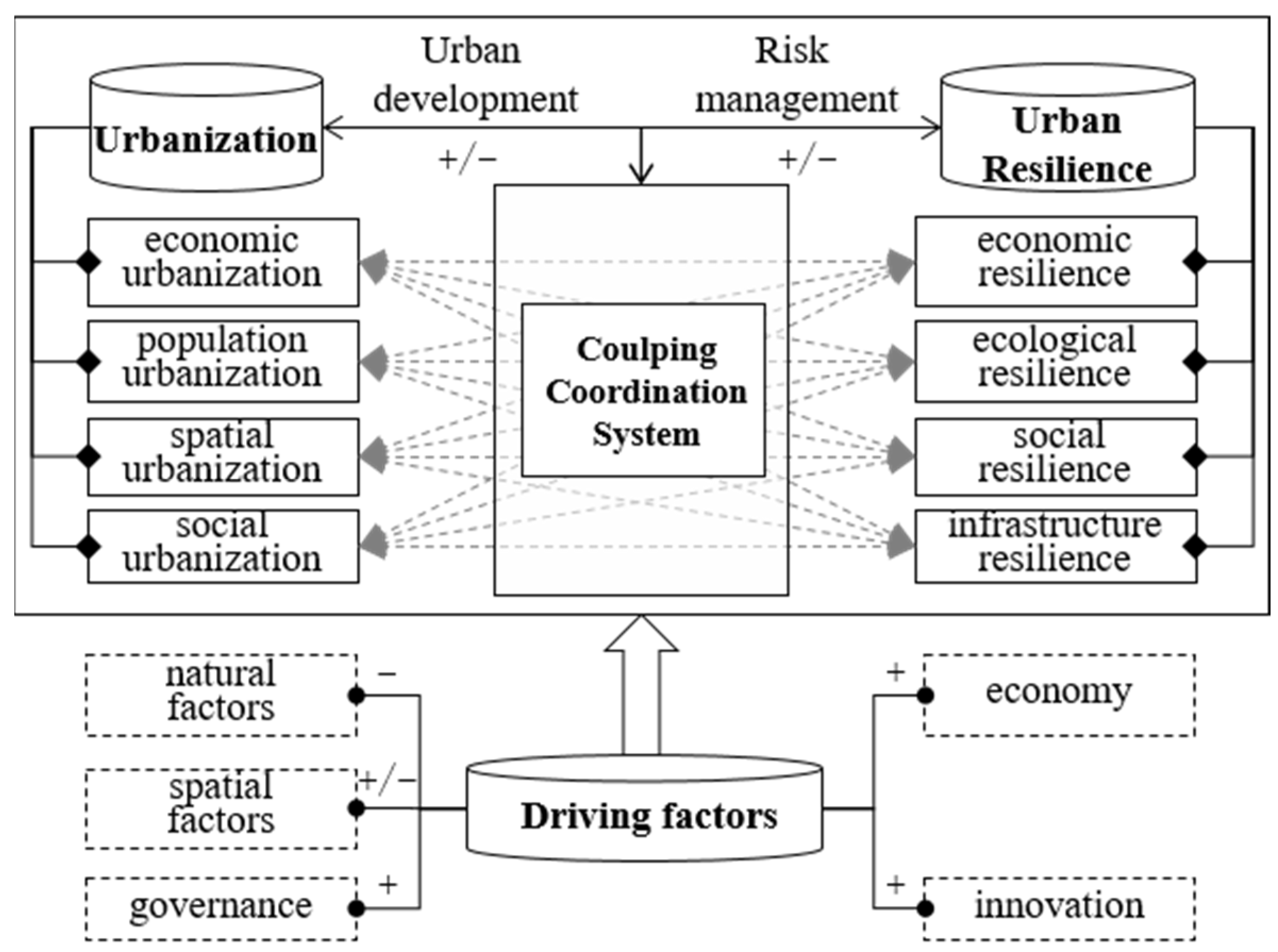
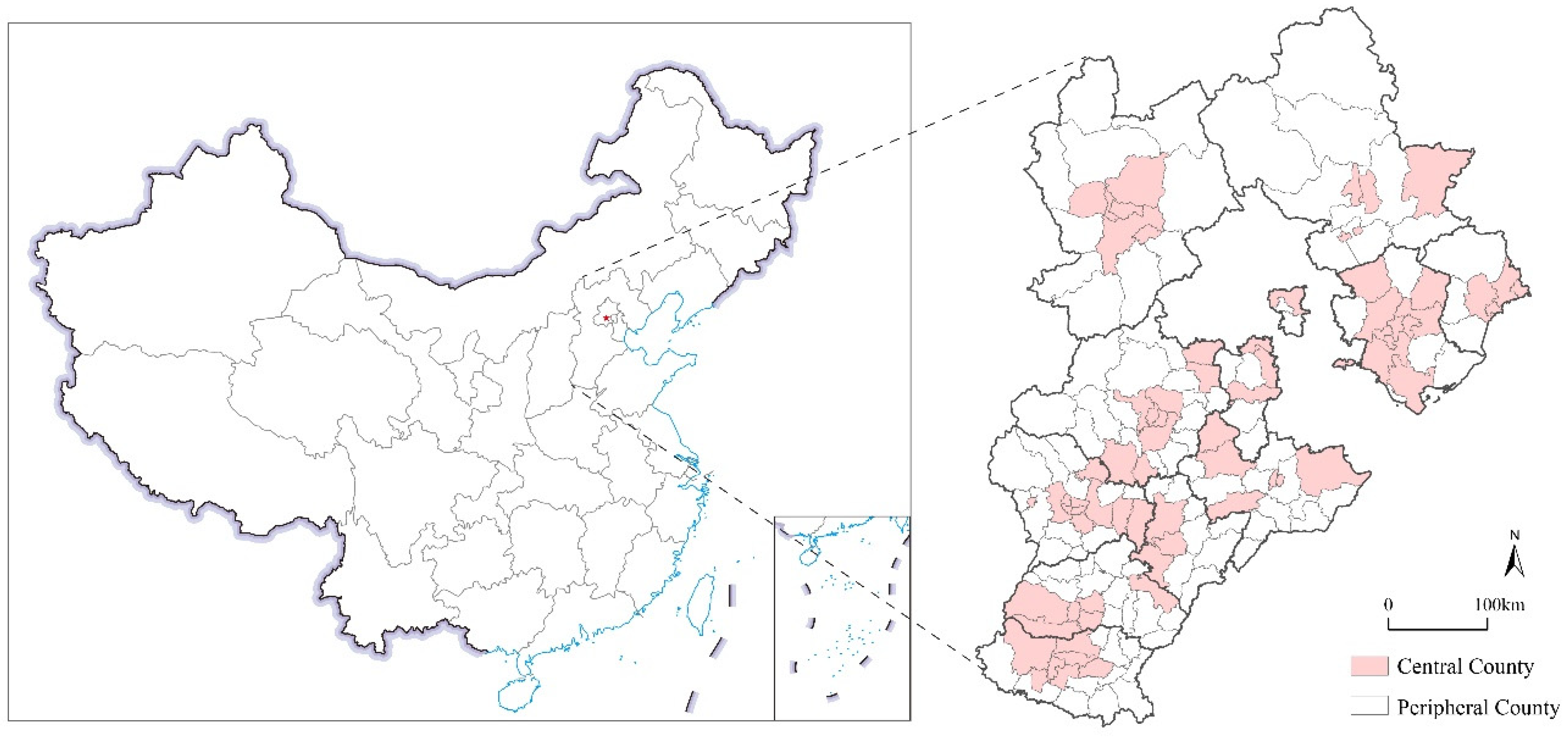

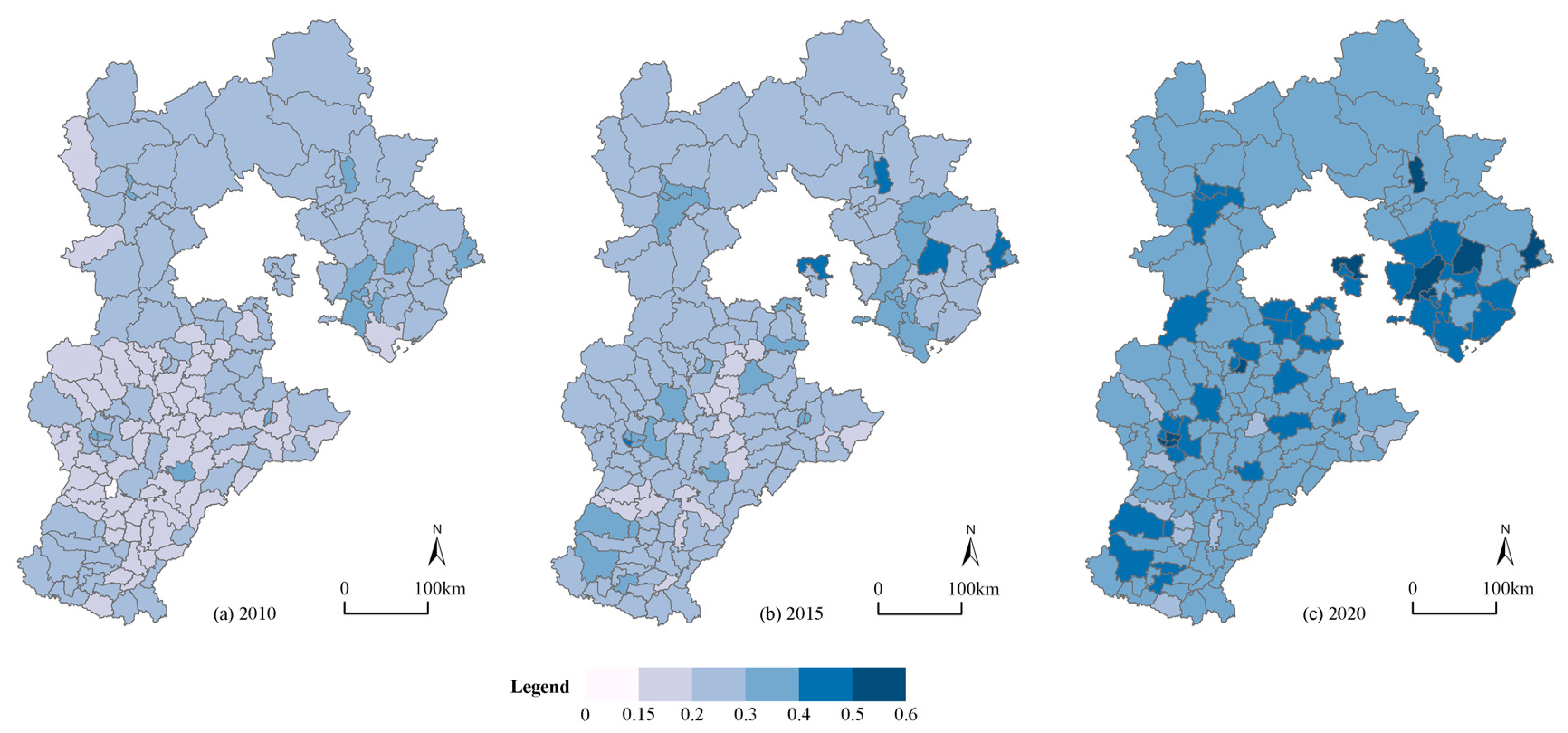
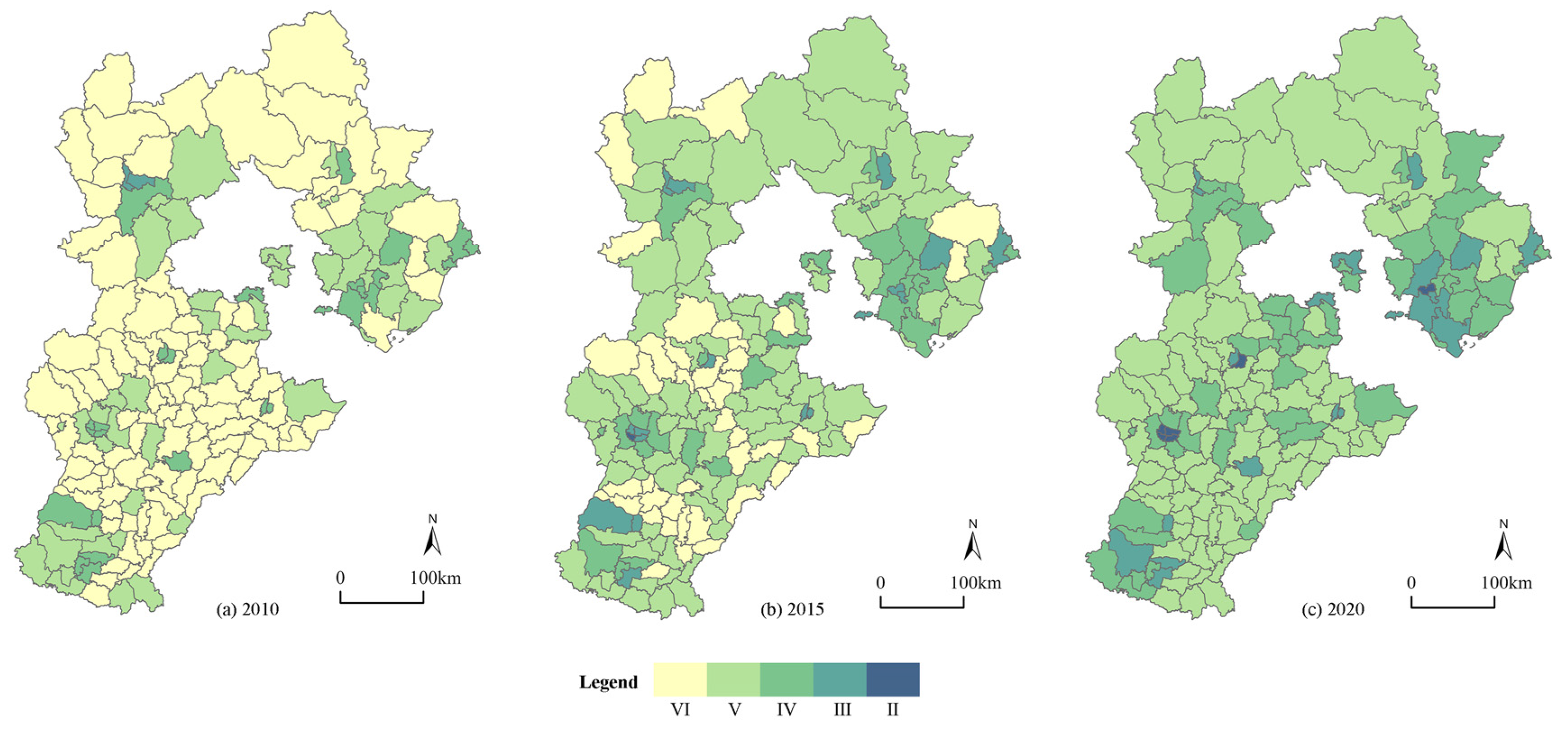
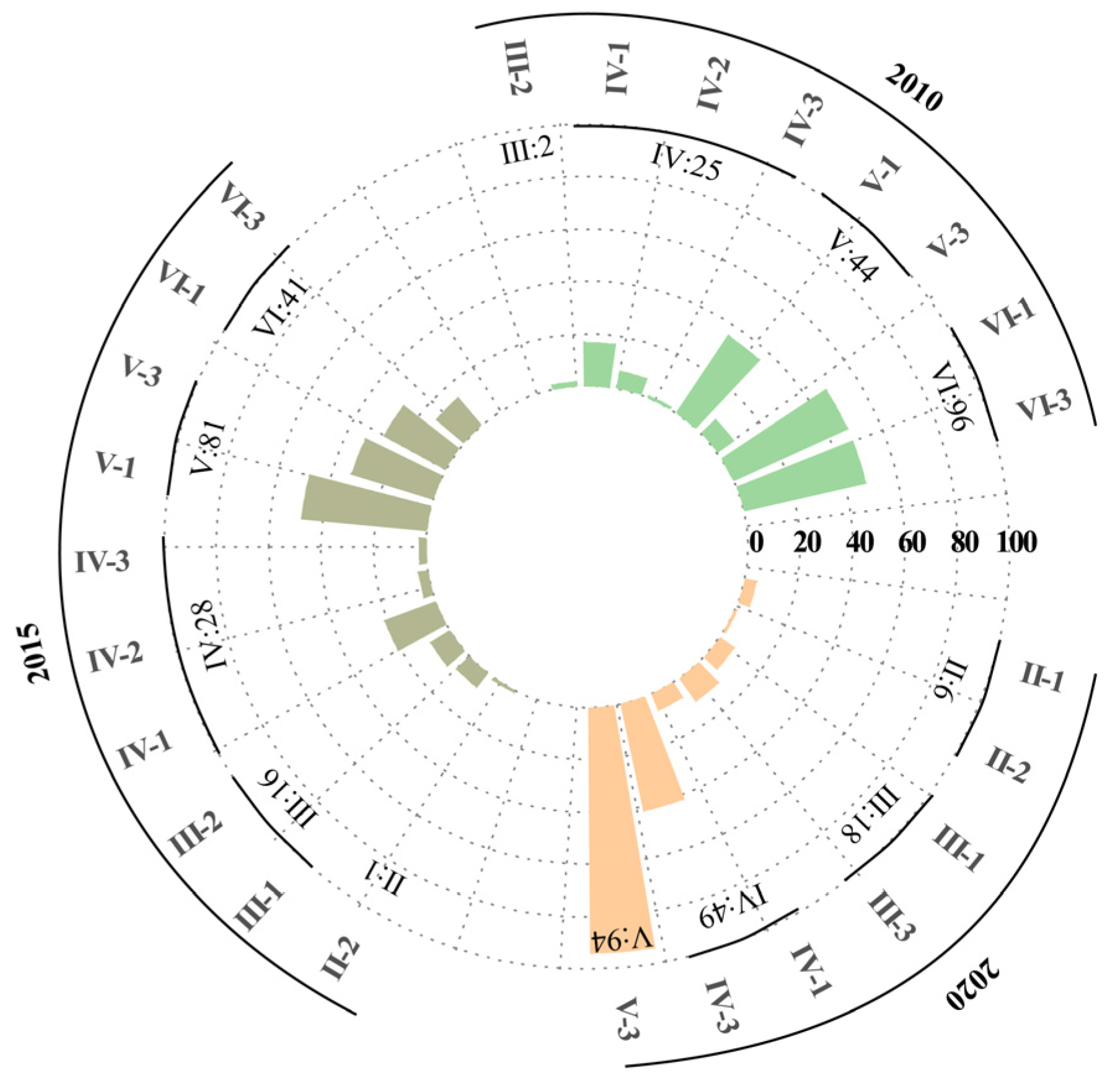
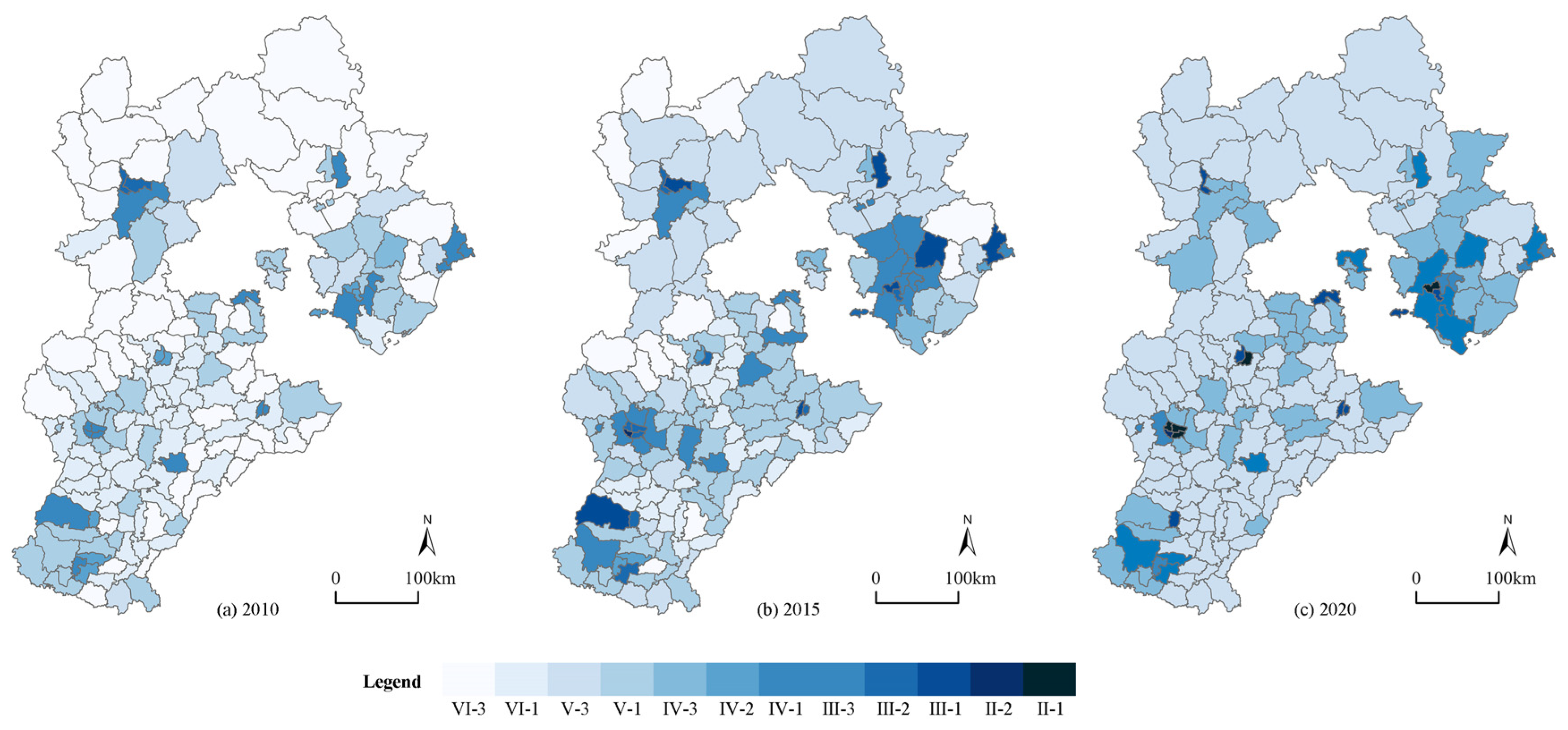

| Subsystem | Evaluation Indicators | Sources |
|---|---|---|
| Population urbanization | Percentage of non-agricultural population, proportion of employment in secondary and tertiary industries | Wang [64], Li [58], Liu [59], Shang [65], Liu [66] |
| Spatial urbanization | Urban population density, urban construction land (per 10,000 people), proportion of districts constructed in urban areas, transportation network density | Li [58], Liu [59], Lv [13], Long [67] |
| Economic urbanization | GDP, GDP per capita, proportion of the added value of the second and tertiary industry to GDP, gross industrial output value per capita, local fiscal revenue per capita, total fixed asset investment | He [57], Liu [59], Shang [65] |
| Social urbanization | Total retail sales of consumer goods per capita, consumption level of the residents per capita, number of phones (per 10,000 households), number of internet users (per 10,000 people), number of doctors (per 10,000 people), per capita disposable income of urban residents, people with a university degree, public library collections (per 10,000 people), number of social welfare adoption units (per 10,000 people) | Wang [64], He [57], Li [58], Liu [59], Lu [68], Shang [65] |
| Subsystem | Evaluation Indicators | Sources |
|---|---|---|
| Economic resilience | GDP per capita, GDP growth rate, amount of foreign investment utilized per capita, employment rate, energy intensity, tertiary industry as percentage to GDP, scientific research fund intensity, urban industrial innovation index, ratio of large-to-small businesses, large retail stores (per 10,000 people) | Cutter [61], Chu [69], Hu [27], Chen [49], Zhao [63] |
| Ecological resilience | Green coverage rate of built-up area, area of public green land per capita, NDVI, ecosystem stress index; air quality–excellent days ratio, ratio of centralized wastewater treatment, ratio of industrial solid wastes that are comprehensively utilized, mean annual concentration of PM2.5, carbon emission, land in wetlands, biodiversity, average percent perviousness | Cutter [61], Zhao [63], Kammouh [70], Delgado [53], Abdrabo [71] |
| Social resilience | Population with college education, population below 65 years of age, urban disposable income per capita, living area of urban residents per capita, urban population density, proportion of expenditure for social security and employment in fiscal expenditure, urban registered unemployment rate, urban Engel coefficient, number of undergraduates in regular HEIs, psychosocial facilities (per 10,000 people), families that provide telephone service, families with at least one car, community values cohesion | Cutter [61], Zhao [63], Cutter [60] |
| Infrastructure resilience | Road surface area per capita, number of buses owned (per 10,000 people), density of water supply pipelines in built-up area, density of sewers in built-up area, number of internet services (per 100 people), number of mobile telephones (per 100 people), night light, emergency shelter area per capita, housing stock construction quality, lifelines and critical infrastructure | Kammouh [70], Zhao [63], Cutter [61], Qiang [72] |
| Institutional resilience | Urban household registered population as percentage of total population, proportion of joining urban basic pension insurance for employees, fiscal expenditure per capita, urban maintenance and construction funds per capita, proportion of employees of enterprises, institutions and government in population, unit density of hospitals and health centers, number of doctors (per 10,000 people), performance regimes-state capital | Cutter [61], Zhao [63], Hu [27] |
| Indicator Type | Subsystem | Evaluation Indicator | Meaning | Nature |
|---|---|---|---|---|
| Urbanization | Economic urbanization | A1 | total amount of urban economic production | + |
| A2 | ratio of non-agricultural production output | + | ||
| Population urbanization | A3 | ratio of non-farm workers | + | |
| A4 | population urbanization rate | + | ||
| Spatial urbanization | A5 | urban space expansion | + | |
| A6 | per capita urban space resources | + | ||
| Social urbanization | A7 | social welfare level | + | |
| A8 | social consumption level | + | ||
| Urban resilience | Economic resilience | B1 | economic development level | + |
| B2 | level of economic growth | + | ||
| B3 | economic recovery capability | + | ||
| B4 | industrial production capacity | + | ||
| Ecological resilience | B5 | pre-disaster mitigation capabilities of ecosystems | + | |
| B6 | green industrial development level | − | ||
| B7 | − | |||
| B8 | disaster reduction capacity of urban ecosystem | + | ||
| Social resilience | B9 | the human loss that may result from the disaster | − | |
| B10 | disaster preparedness of the education system | + | ||
| B11 | disaster response capabilities of health systems | + | ||
| Infrastructure resilience | B12 | disaster-carrying capacity of urban space | + | |
| B13 | post-disaster response capability of infrastructure | + | ||
| B14 | disaster-response capability of communication technology | + |
| Indicator Type | Evaluation Indicator | Meaning |
|---|---|---|
| Natural factors | RDLS | The relative height difference of the terrain within the county unit |
| Spatial factors | AWMSI | To measure the shape complexity of built-up areas, urban irregular sprawl typically raises AWMSI |
| BCI | To measure the form compactness of built-up areas, a higher BCI suggests a more compact urban structure | |
| Governance | ZC | The higher the public expenditure, the stronger the governance capacity of the government |
| Economy | CY | The higher the industrial output value ratio is, the stronger the industrial advanced degree is |
| Innovation | CX | The newer the scientific and technological enterprises are, the stronger the technological innovation capacity is |
| Classification | Criteria | Sub-Classification | Systematic Comparison |
|---|---|---|---|
| High coordination (I) | [0.8, 1] | High coordination (I-1) | 0 ≤ |U2 − U1| ≤ 0.1 |
| Lagging urban resilience (I-2) | U1 − U2 > 0.1 | ||
| Lagging urbanization (I-3) | U2 − U1 > 0.1 | ||
| Moderate coordination (II) | [0.7, 0.8) | Moderate coordination (II-1) | 0 ≤ |U2 − U1| ≤ 0.1 |
| Lagging urban resilience (II-2) | U1 − U2 > 0.1 | ||
| Lagging urbanization (II-3) | U2 − U1 > 0.1 | ||
| Mild coordination (III) | [0.6, 0.7) | Mild coordination (III-1) | 0 ≤ |U2 − U1| ≤ 0.1 |
| Lagging urban resilience (III-2) | U1 − U2 > 0.1 | ||
| Lagging urbanization (III-3) | U2 − U1 > 0.1 | ||
| Mild imbalance (IV) | [0.5, 0.6) | Mild imbalance (IV-1) | 0 ≤ |U2 − U1| ≤ 0.1 |
| Lagging urban resilience (IV-2) | U1 − U2 > 0.1 | ||
| Lagging urbanization (IV-3) | U2 − U1 > 0.1 | ||
| Moderate imbalance (V) | [0.4, 0.5) | Moderate imbalance (V-1) | 0 ≤ |U2 − U1| ≤ 0.1 |
| Lagging urban resilience (V-2) | U1 − U2 > 0.1 | ||
| Lagging urbanization (V-3) | U2 − U1 > 0.1 | ||
| Serious imbalance (VI) | [0, 0.4) | Serious imbalance (VI-1) | 0 ≤ |U2 − U1| ≤ 0.1 |
| Lagging urban resilience (VI-2) | U1 − U2 > 0.1 | ||
| Lagging urbanization (VI-3) | U2 − U1 > 0.1 |
| Coupling Coordination Degree | Moran I | Z Score |
|---|---|---|
| CCD_2010 | 0.397 *** | 7.997 |
| CCD_2015 | 0.429 *** | 8.623 |
| CCD_2020 | 0.442 *** | 8.924 |
| Test | LM Spatial Lag | Robust LM Spatial Lag | LM Spatial Error | Robust LM Spatial Error | LR Test-Spatial Lag | LR Test-Spatial Error | Hausman |
|---|---|---|---|---|---|---|---|
| W1 | 38.187 *** | 20.643 *** | 18.884 *** | 1.341 | 42.94 *** | 22.32 *** | 20.73 *** |
| W2 | 85.643 *** | 20.131 *** | 156.421 *** | 90.909 *** | 154.81 *** | 32.71 *** | 30.67 *** |
| Model W1 | (1) RE | (2) FE | (3) FEboth |
|---|---|---|---|
| Main | |||
| RDLS | −0.027 (−1.147) | −0.035 (−0.680) | −0.037 (−0.753) |
| AWMSI | 0.036 *** (2.973) | 0.033 *** (7.600) | 0.023 *** (5.950) |
| BCI | −0.019 ** (−2.229) | −0.020 ** (−2.325) | −0.018 *** (−4.028) |
| ZC | 0.100 *** (5.514) | 0.099 *** (2.689) | 0.077 ** (2.131) |
| CY | 0.052 ** (2.280) | 0.055 *** (14.913) | 0.044 *** (7.326) |
| KJ | 0.042 *** (2.831) | 0.042 * (1.811) | 0.047 ** (2.168) |
| _cons | 0.274 *** (8.610) | 0.323 *** (4.994) | 0.413 *** (9.666) |
| Wx | |||
| RDLS | 0.013 (0.249) | 0.026 (0.615) | 0.016 (0.506) |
| AWMSI | −0.081 **(−2.283) | −0.087 *** (−6.646) | −0.100 *** (−7.011) |
| BCI | 0.017(0.749) | 0.017 (0.361) | 0.012 (0.321) |
| ZC | 0.137 *** (4.532) | 0.149 *** (6.051) | 0.038 ** (2.031) |
| CY | 0.068 * (1.890) | 0.072 *** (6.483) | 0.025 (1.247) |
| KJ | −0.001 (−0.025) | 0.001 (0.045) | 0.022 (1.477) |
| Spatial | |||
| rho | 0.355 *** (7.281) | 0.320 *** (6.667) | 0.157 *** (3.232) |
| Model W2 | (1) RE | (2) FE | (3) FEboth |
|---|---|---|---|
| Main | |||
| RDLS | −0.000 (−0.600) | −0.003 *** (−3.648) | −0.003 *** (−3.921) |
| AWMSI | 0.072 *** (4.064) | 0.031 ** (2.068) | 0.024 * (1.652) |
| BCI | −0.000 (−0.010) | −0.010 (−1.090) | −0.010 (−1.059) |
| ZC | 0.096 *** (5.959) | 0.098 *** (7.646) | 0.082 *** (6.418) |
| CY | 0.040 *** (2.652) | 0.040 *** (3.442) | 0.035 *** (3.001) |
| KJ | 0.036 ** (2.510) | 0.031 *** (2.782) | 0.031 *** (2.870) |
| Wx | |||
| RDLS | 0.000 * (1.909) | 0.006 *** (5.029) | 0.004 *** (3.255) |
| AWMSI | 0.069 * (1.917) | −0.094 *** (−2.833) | −0.105 *** (−3.219) |
| BCI | 0.088 *** (3.697) | 0.023 (1.168) | 0.016 (0.822) |
| ZC | 0.068 *** (2.693) | 0.111 *** (4.709) | 0.035 ** (1.287) |
| CY | 0.004 (0.117) | 0.040 (1.581) | 0.020 (0.782) |
| KJ | −0.027 (−0.897) | 0.026 (1.064) | 0.026 (1.103) |
| Spatial | |||
| rho | 0.639 *** (17.202) | 0.393 *** (7.583) | 0.224 *** (3.532) |
Publisher’s Note: MDPI stays neutral with regard to jurisdictional claims in published maps and institutional affiliations. |
© 2022 by the authors. Licensee MDPI, Basel, Switzerland. This article is an open access article distributed under the terms and conditions of the Creative Commons Attribution (CC BY) license (https://creativecommons.org/licenses/by/4.0/).
Share and Cite
Shi, W.; Tian, J.; Namaiti, A.; Xing, X. Spatial-Temporal Evolution and Driving Factors of the Coupling Coordination between Urbanization and Urban Resilience: A Case Study of the 167 Counties in Hebei Province. Int. J. Environ. Res. Public Health 2022, 19, 13128. https://doi.org/10.3390/ijerph192013128
Shi W, Tian J, Namaiti A, Xing X. Spatial-Temporal Evolution and Driving Factors of the Coupling Coordination between Urbanization and Urban Resilience: A Case Study of the 167 Counties in Hebei Province. International Journal of Environmental Research and Public Health. 2022; 19(20):13128. https://doi.org/10.3390/ijerph192013128
Chicago/Turabian StyleShi, Weihao, Jian Tian, Aihemaiti Namaiti, and Xiaoxu Xing. 2022. "Spatial-Temporal Evolution and Driving Factors of the Coupling Coordination between Urbanization and Urban Resilience: A Case Study of the 167 Counties in Hebei Province" International Journal of Environmental Research and Public Health 19, no. 20: 13128. https://doi.org/10.3390/ijerph192013128
APA StyleShi, W., Tian, J., Namaiti, A., & Xing, X. (2022). Spatial-Temporal Evolution and Driving Factors of the Coupling Coordination between Urbanization and Urban Resilience: A Case Study of the 167 Counties in Hebei Province. International Journal of Environmental Research and Public Health, 19(20), 13128. https://doi.org/10.3390/ijerph192013128







